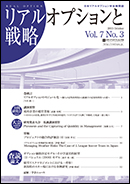Volume 7, Issue 3
Displaying 1-7 of 7 articles from this issue
- |<
- <
- 1
- >
- >|
-
2015Volume 7Issue 3 Pages 1-2
Published: 2015
Released on J-STAGE: January 31, 2019
Download PDF (1051K)
-
2015Volume 7Issue 3 Pages 3-6
Published: 2015
Released on J-STAGE: February 13, 2019
Download PDF (1141K)
-
2015Volume 7Issue 3 Pages 7-10
Published: 2015
Released on J-STAGE: January 31, 2019
Download PDF (1094K)
-
2015Volume 7Issue 3 Pages 11-15
Published: 2015
Released on J-STAGE: January 31, 2019
Download PDF (1209K)
-
2015Volume 7Issue 3 Pages 16-21
Published: 2015
Released on J-STAGE: January 31, 2019
Download PDF (1070K)
Reviewed Papers
-
2015Volume 7Issue 3 Pages 22-31
Published: 2015
Released on J-STAGE: January 31, 2019
Download PDF (1091K) -
2015Volume 7Issue 3 Pages 32-39
Published: 2015
Released on J-STAGE: April 13, 2020
Download PDF (888K)
- |<
- <
- 1
- >
- >|
